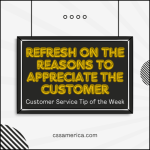
Webster’s has a couple definitions of health. One is “not being sick.” True, but I don’t like defining something by simply saying what it’s not.
Another definition is “vigor of body, mind, and spirit” – much more positive! Let’s apply that to one of our favorite customer service people – you!
The Body – Human energy is something that has not been scientifically studied like it should. Sure, there’s more sleep recommended, Red Bull, 5-hour Energy shots, healthy eating, etc. that are supposed to give you energy. But the reality is, I’ve never heard of a study that identified the true source of “human physiological energy.” So to create physical vigor, that “body energy,” may be difficult. However, in customer service you at least want to have physical health that enables you to go TO the customer, to quickly respond to e-mails, to be there on time for them, to go to the co-worker to address the issue. If you don’t have the energy for these basic customer care responsibilities, work on your body health.
The Mind – Tying into body health, those who want to be great at customer service must be able to focus on the task and the customer. You have to be able to take in the considerations of the customer, co-worker, and company, finding solutions that will – long-term – be best. You have to think outside yourself, identifying what’s truly best for others, and realizing that the more successful those are that you serve, the more success you’ll have, as well. To create the healthier mind, work on your focus, your consideration for others, and making decisions that are best for the long-term.
The Spirit – What I generally love about caddies of professional golfers is that their conversations with the pros revolve around two things – helping make the best decision, and being exceptionally positive! That positivity with the pros improves their comfort level and confidence in hitting the right shot in the best manner. Positivity can drive confidence and higher results. So are you a good caddy for yourself? Do you spend more time telling yourself positives than beating yourself up for issues? Be a good caddy to yourself. Foster a healthy spirit.
Become healthier to improve your service to others. Work to build vigor into your body, mind, and spirit.
Signup for FREE Tips! Contact Us More Resources for You Visit Our Home Page























